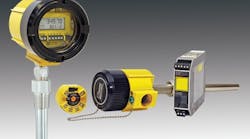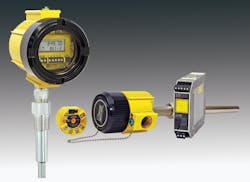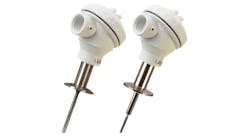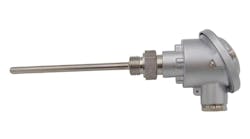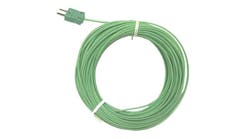Moore Industries has released the SIL 3-capable STZ Safety Smart HART temperature transmitter family. Part of the company's FS Functional Safety Series, the STZ is designed for use in safety instrumented systems (SISs) to conform with 61508:2010 standards.
The company has been a leader in safety trips and alarms since 1968. "When the IEC 61508 functional safety (FS) specification gave us methods for designing hardware and firmware suitable for safety systems, we set out to design a set of products to meet the spec," says Scott Saunders, CEO, Moore Industries. "We started the FS Series with the STA safety trip alarm and logic solver. We then produced the SRM safety relay module, our SSX/SST safety isolators and signal splitter that are capable of passing important and often critical HART data, and now the STZ Safety temperature transmitter. We paint them yellow and black, so customers have an easy way to identify that these products are designed and built for functional safety."
Moore Industries' new SIL 3-capable STZ Safety Smart HART Temperature Transmitter family comes in three configurations: a conventional hockey puck with display, a DIN rail-mount version and a compact, blind hockey puck without display.
Credit: Moore Industries
The new STZ offers a dual sensor input that reduces process interruptions. Backup and fail-over protection allow either of the sensors or inputs to be designated as the primary measurement, with the secondary input acting as the backup sensor. The dual sensor input also allows for average and differential measurements, along with high-select and low-select options.
The STZ also features Moore Industries' Device Intelligence, a series of features designed for smarter control and monitoring including:
• Sensor drift and corrosion detection that checks and alerts users when the sensor is drifting out of a preset range, or when the resistance due to corrosion or pending thermocouple failure exceeds set parameters.
• Smart range alarms with four HART alarms—set to any input or calculated input—detect when the variable is in or out of user preset limits.
• A high-availability option to select how the analog output (AO) behaves when there is an input failure or out-of-range value detected by the transmitter. "Spurious trips are a major challenge with safety instrumentation," says Tina Lockhart, director of engineering, Moore Industries. "We want the process to keep running, so a user can prevent a minor malfunction from going to a failure mode by checking the box for high availability. You have two sensors averaging, and if one fails, you can choose whether to accept the remaining signal or not. You can also set it, so if the sensors drift apart, you'll get an alarm at a certain delta level."
• Input simulation capability allows manual input of a direct or calculated value, so users can test the analog output or any HART diagnostic and range alarms, which assists in proof testing.
The STZ is HART 7-compliant, with exception-based reporting and dynamic variable mapping. It's HART- and DTM-programmable with user-oriented basic configuration for fast and accurate setup. Using the HART DD, it can be configured and interrogated on the 4-20 mA loop via any HART handheld or HART-compatible host. Users can also program or monitor the transmitter with any FDT-compliant host or program, such as PACTware using the STZ DTM.
To preserve safety integrity, "A 'no HART' or 'read only' HART mode keeps HART from being accessed from everywhere in the loop, so it can't be inadvertently reprogrammed," says Lockhart. "It can be set so you can get diagnostic data, but not be able to program, or you can turn it completely off, so access is only through DTM."
To learn more, visit www.miinet.com.

Leaders relevant to this article:
